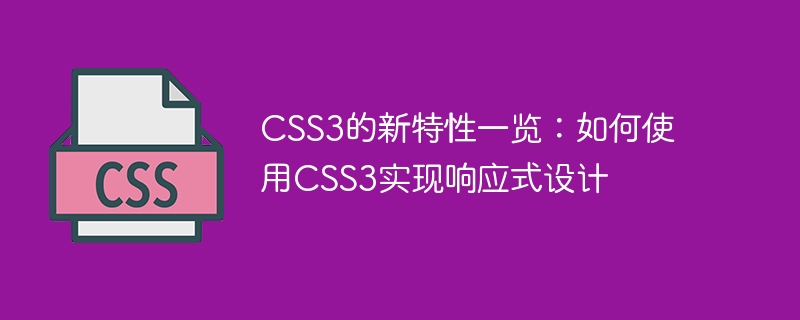Home >Web Front-end >CSS Tutorial >An overview of the new features of CSS3: How to use CSS3 to implement responsive design
An overview of the new features of CSS3: How to use CSS3 to implement responsive design
- WBOYWBOYWBOYWBOYWBOYWBOYWBOYWBOYWBOYWBOYWBOYWBOYWBOriginal
- 2023-09-08 17:25:501785browse

Overview of the new features of CSS3: How to use CSS3 to achieve responsive design
With the popularity of mobile devices, responsive design (Responsive Design) has become a modern web design important concepts in . It enables a website to have a great user experience on different screen sizes and automatically adapts to a variety of devices, including desktops, tablets, and mobile phones. CSS3, as the core language for web page style design, provides many new features, making it easier and more flexible to implement responsive design. In this article, we will introduce some new features of CSS3 and give corresponding code examples.
- Media Queries
Media queries are the basis of responsive design, which allow different CSS rules to be applied according to the characteristics of the device (such as screen width, screen orientation, etc.). The following is a simple media query example:
@media screen and (max-width: 600px) {
body {
background-color: yellow;
}
}The above code indicates that when the screen width is less than or equal to 600 pixels, the background color of the body element is set to yellow. Through media queries, we can write specific CSS rules for different screen sizes to achieve responsive layout.
- Flexbox Layout (Flexbox)
Flexbox layout is a powerful feature in CSS3, which can automatically adjust the position and size of elements in a row or column to adapt to different screen sizes. . The following is a simple example of using flexible box layout:
.container {
display: flex;
justify-content: center;
align-items: center;
}
.item {
flex: 1;
margin: 10px;
text-align: center;
}In the above code, .container is a container element using display: flexTo enable flexible box layout. justify-content: center Center the content horizontally, align-items: center Center the content vertically. .item is a child element in the container. flex: 1 is used to make the element adapt to the width of the container, and margin is used to set the spacing of the element.
- Transition effects (Transitions)
Transition effects can allow the attribute values of an element to smoothly transition to new values within a period of time, thus making the animation effect smoother. The following is a simple transition effect example:
.button {
transition: background-color 0.5s ease;
}
.button:hover {
background-color: blue;
}In the above code, .button is a button element, and transition is used to define the transition effect : background-color represents the attribute name of the attribute change, 0.5s represents the transition time, ease represents the speed curve of the transition effect. When the mouse is hovered over the button, the background color transitions smoothly to blue.
- Media Nested (Nested Media Queries)
Media nesting is a powerful feature in CSS3, which allows one media query to be nested within another media query for more precise matching. different devices. The following is a simple media nesting example:
@media screen and (max-width: 600px) {
.container {
flex-direction: column;
}
@media screen and (max-height: 400px) {
.item {
font-size: 12px;
}
}
}In the above code, when the screen width is less than or equal to 600 pixels, the direction of the container element changes to portrait. On this basis, when the screen height is 400 pixels or less, the font size of the element becomes 12 pixels. Media nesting allows us to more precisely specify style rules for different screen sizes.
Through the above code examples, we can see the great potential of the new features of CSS3 in realizing responsive design. They allow us to more flexibly and precisely control web page layout and styling to adapt to different devices and screen sizes. Of course, this is only a small part of the features of CSS3, and there are many other useful features waiting for us to explore and apply.
To sum up, CSS3 provides a wealth of tools and functions for responsive design. Features such as media queries, flexible box layout, transition effects, and media nesting provide us with greater freedom and flexibility, making responsive design easier to implement. By continuously learning and applying the new features of CSS3, we can build more elegant and user-friendly responsive websites.
The above is the detailed content of An overview of the new features of CSS3: How to use CSS3 to implement responsive design. For more information, please follow other related articles on the PHP Chinese website!

